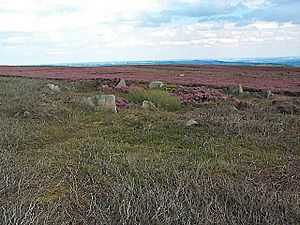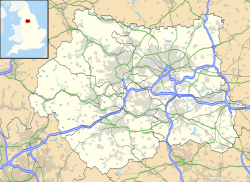Grubstones facts for kids
 |
|
| Location | West Yorkshire |
|---|---|
| Coordinates | 53°53′54″N 1°47′38″W / 53.89836°N 1.79400°W |
| Type | Stone circle |
| History | |
| Periods | Bronze Age |
The Grubstones is an ancient stone circle found on Burley Moor in West Yorkshire, England. People believe it was either a stone circle with a surrounding bank or a type of ring cairn. A ring cairn is a circular mound of stones, often built around a central open space.
Where are the Grubstones?
The Grubstones circle is located on Burley Moor. This moor is just east of Ilkley Moor, another well-known area. The circle sits on a gentle slope that faces south, meaning it gets a lot of sunshine.
It is about 800 metres (half a mile) south-east of another famous ancient site called the Twelve Apostles. South-east of the Grubstones, you can also find several large stone mounds called cairns. One of these is known as The Skirtful of Stones.
What do the Grubstones look like?
The Grubstones circle is about 10 metres (33 feet) wide. It is almost perfectly round. Today, twenty stones from the original circle are still standing. These stones are placed inside a low bank of earth, which is about 1.8 metres (6 feet) wide.
Experts have described the Grubstones in different ways. Some call it a cairn circle, a ring cairn enclosure, or simply a stone circle. About one-third of the circle on its south side has been damaged. This damage was caused by structures called "shooting butts," which are used for target practice.
Inside the circle, there are four large, loose stones. These might have come from the damaged part of the circle. Around 1846, people dug inside the circle to explore it. They found evidence of a cremation, which is when a body is burned. Along with this, they found a flint spearhead, a sharp tool or weapon made from stone.
In the 20th century, the site was damaged again. A rectangular mound of earth was built there. This mound was called an "orgone accumulator." Some people believed that "orgone" was a special energy or life force. They thought this energy could be collected and stored in the accumulator to help treat illnesses.


